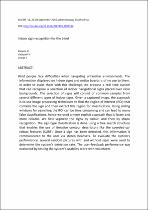JavaScript is disabled for your browser. Some features of this site may not work without it.
- ResearchSpace
- →
- Research Publications/Outputs
- →
- Conference Publications
- →
- View Item
| dc.contributor.author |
Kunene, D

|
|
| dc.contributor.author |
Vadapalli, H

|
|
| dc.contributor.author |
Cronje, J

|
|
| dc.date.accessioned | 2017-11-10T09:58:08Z | |
| dc.date.available | 2017-11-10T09:58:08Z | |
| dc.date.issued | 2016-09 | |
| dc.identifier.citation | Kunene, D., Vadapalli, H. and Cronje, J. 2016. Indoor sign recognition for the blind. SAICSIT ’16, 26-28 September 2016, Johannesburg, South Africa | en_US |
| dc.identifier.isbn | 978-1-4503-4805 | |
| dc.identifier.uri | https://dl.acm.org/citation.cfm?id=2987530 | |
| dc.identifier.uri | doi>10.1145/2987491.2987530 | |
| dc.identifier.uri | http://hdl.handle.net/10204/9751 | |
| dc.description | Copyright: 2016 ACM. Due to copyright restrictions, the attached PDF file only contains the abstract of the full text item. For access to the full text item, kindly consult the publisher's website. | en_US |
| dc.description.abstract | Blind people face difficulties when navigating unfamiliar environments. The information displayed on indoor signs and notice boards is of no use to them. In order to assist them with this challenge, we propose a real time system that can recognise a selection of indoor navigational signs placed over clear backgrounds. The selection of signs will consist of common samples from several different types of indoor signs. Given a captured image, the approach is to use image processing techniques to find the region of interest(ROI) that contains the sign and then extract this region for classification. Using sliding windows for searching the ROI can be time consuming and can lead to many false classifications, hence we used a more explicit approach that is faster and more reliable. We first segment the signs by colour, and then by shape recognition. The sign-type classification is done using a tree search structure that enables the use of iterative contour descriptors like the speeded-up-robust features(SURF). Once a sign has been detected, this information is communicated to the user via stereo headsets. To evaluate the system's performance, several random pictures with and without signs were used to determine the system's detection rate. The user-feedback performance was evaluated by testing the system's usability score with volunteers. | en_US |
| dc.language.iso | en | en_US |
| dc.publisher | ACM Digital Library | en_US |
| dc.relation.ispartofseries | Worklist;17593 | |
| dc.subject | Sign-recognition | en_US |
| dc.subject | Shape-detection | en_US |
| dc.subject | Colour-segmentation | en_US |
| dc.subject | Visual aid system | en_US |
| dc.subject | Computer-vision | en_US |
| dc.title | Indoor sign recognition for the blind | en_US |
| dc.type | Conference Presentation | en_US |
| dc.identifier.apacitation | Kunene, D., Vadapalli, H., & Cronje, J. (2016). Indoor sign recognition for the blind. ACM Digital Library. http://hdl.handle.net/10204/9751 | en_ZA |
| dc.identifier.chicagocitation | Kunene, D, H Vadapalli, and J Cronje. "Indoor sign recognition for the blind." (2016): http://hdl.handle.net/10204/9751 | en_ZA |
| dc.identifier.vancouvercitation | Kunene D, Vadapalli H, Cronje J, Indoor sign recognition for the blind; ACM Digital Library; 2016. http://hdl.handle.net/10204/9751 . | en_ZA |
| dc.identifier.ris | TY - Conference Presentation AU - Kunene, D AU - Vadapalli, H AU - Cronje, J AB - Blind people face difficulties when navigating unfamiliar environments. The information displayed on indoor signs and notice boards is of no use to them. In order to assist them with this challenge, we propose a real time system that can recognise a selection of indoor navigational signs placed over clear backgrounds. The selection of signs will consist of common samples from several different types of indoor signs. Given a captured image, the approach is to use image processing techniques to find the region of interest(ROI) that contains the sign and then extract this region for classification. Using sliding windows for searching the ROI can be time consuming and can lead to many false classifications, hence we used a more explicit approach that is faster and more reliable. We first segment the signs by colour, and then by shape recognition. The sign-type classification is done using a tree search structure that enables the use of iterative contour descriptors like the speeded-up-robust features(SURF). Once a sign has been detected, this information is communicated to the user via stereo headsets. To evaluate the system's performance, several random pictures with and without signs were used to determine the system's detection rate. The user-feedback performance was evaluated by testing the system's usability score with volunteers. DA - 2016-09 DB - ResearchSpace DP - CSIR KW - Sign-recognition KW - Shape-detection KW - Colour-segmentation KW - Visual aid system KW - Computer-vision LK - https://researchspace.csir.co.za PY - 2016 SM - 978-1-4503-4805 T1 - Indoor sign recognition for the blind TI - Indoor sign recognition for the blind UR - http://hdl.handle.net/10204/9751 ER - | en_ZA |






